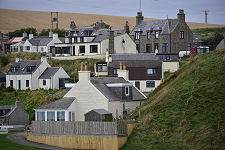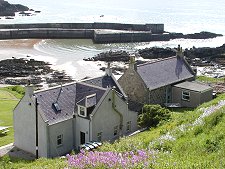 Collieston from St Catharine's Dub |
Collieston is the first safe haven in over fifteen miles of beaches and dunes stretching north from Aberdeen. It was established as a fishing village by the 1500s and much of the pattern of the settlement you can see today dates back to then.
Collieston marks a very sharp change in the landscape. Its cliffs and rocky bays extend to the north, while to the south is the huge sand dune system of the Forvie National Nature Reserve. This stretches for three miles along the shore to the mouth of the River Ythan near Newburgh. The dunes also stretch for over a mile inland, producing a highly unusual environment.
Man has tried and failed to tame the Forvie Sands. At their centre are the remains of Forvie Kirk, built in the 1100s. This is all that remains of the village of Forvie, once a thriving community but buried by shifting dunes during a storm in 1413. (Continues below image...)
 Collieston from St Catharine's Dub |
Collieston flourished as a fishing village in the 1600s and 1700s and made its name as the origin of Collieston Speldings. These were salted and sun-dried haddock and whiting, and they proved a popular delicacy as far afield as Edinburgh and London. The whole village was involved in fishing. In 1791 it was recorded that school attendance dropped by half during summer when children collected mussels and dug bait for the line fishing that underpinned Collieston's economy.
However, drift netting had developed as a more efficient means of fishing by the mid 1800s and Collieston was too small to provide a safe harbour for the larger boats needed. As a result, the focus of the industry shifted to places like Peterhead, and many of Collieston's residents moved with it.
Collieston also proved an ideal location for another industry. With many sea caves in the surrounding cliffs, and with small coves and shingle beaches, it was excellent territory for smugglers. In the late 1700s it was estimated by the Excise that up to 8,000 gallons of foreign spirits were being illegally landed in the area every month.
This all came to a head on 17 December 1798. Excisemen lying in wait surprised a group of smugglers unloading their barrels of spirit. In the skirmish that followed the most notorious of the smugglers, Phillip Kennedy, was killed by a blow from an exciseman's cutlass.
On the cliffs a mile to the north of Collieston are the slight remains of Old Slains Castle. This was blown up by James VI in 1594 to punish the Earl of Erroll for becoming involved in a Catholic plot against him. The Earl was later forgiven and went on to build Slains Castle, six miles up the coast, in 1597.
There is a tangible link to this plot still to be found near Collieston. The remains of a Spanish warship lie just off the rocky point of St Catharine's Dub, near Collieston's main car park. The Santa Caterina was said to have sunk while trying to land arms to support the Earl of Erroll's rebellion.
 Collieston from its Pier |

|
|
|
Visitor InformationView Location on MapWhat3Words Location: ///spinning.grouping.crumb |
 Approaching Collieston |
 Village from Pier |
 Village Houses |
 Beach |
 Collieston Harbour |
 Seen from its Landward End |





